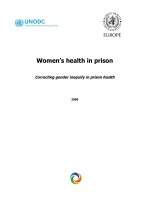Tài liệu Women’s Health and Postsocialist Healthcare Reforms: Lessons from Poland and Eastern Europe ppt
Bạn đang xem bản rút gọn của tài liệu. Xem và tải ngay bản đầy đủ của tài liệu tại đây (87.67 KB, 4 trang )
Mishtal, CAGH
1
Women’s Health and Postsocialist Healthcare Reforms:
Lessons from Poland and Eastern Europe
CAGH – Working Group on Health Insurance Reform
Position Paper, Joanna Mishtal
Current debates about healthcare reform in the US offer an opportunity for anthropologists and
feminist scholars to call attention to the urgent need to improve women’s health through access
to reproductive and sexual healthcare. While both men and women have reproductive and sexual
health needs, women are often more directly involved in prevention of unintended pregnancy,
accessing contraception, and are uniquely affected by pregnancy and childbirth as well as
sexually transmitted infections. Reproductive health has been shown to be a central determinant
of women’s overall health, and therefore universal healthcare coverage should include access to
comprehensive and affordable services that promote reproductive and sexual health (Chavkin et
al. 2010). But access to reproductive and sexual rights and healthcare is also highly politicized
and affected by other agendas, including religious and demographic, in addition to neoliberal.
Based on 21 months of fieldwork in Poland between 2000 and 2007 focusing on the politics of
reproductive health and rights, I briefly summarize here the effects of Polish neoliberal
restructuring on reproductive healthcare.
Lessons from Poland and Eastern Europe
After the fall of state socialism in 1989 Poland, similarly to other East European nations,
embraced neoliberal economic reforms dictated by the global pressures to adopt market solutions
in most areas of transition politics. This shift resulted in major cutbacks in social services and
state healthcare coverage, as well as privatization, decentralization, and deregulation. Formally,
Poland has a universal healthcare system via the National Health Fund, but cuts in coverage have
been substantial: subsidies of medicines dwindled from 100% before 1989 to 35% in 2004, the
lowest in the European Union, and many basic services were removed from universal coverage
known as the “health benefits basket,” resulting in increasing out-of-pocket payments for
patients (Maarse 2006; Tymowska 2001). Although the Polish Constitution explicitly guarantees
every citizen the right to protection of health and equal access to publicly-financed healthcare,
regardless of one’s material situation, the state determines which services are publicly funded.
Thus the constitutional guarantee to health is a right only to the extent that publicly funded
services are actually available.
Poland implemented some of the largest cuts in public health coverage. As of 2009, Poland’s
expenditure on healthcare was 9.8% of total state’s expenditure, the second lowest in the EU
after Latvia (WHO Report 2009). Private health insurance plans are only beginning to be
established and are available only to the wealthy, thus, most people rely on public healthcare and
private care is paid for by users. A national survey indicated that 59% of Poles rely solely on the
public system and never pursue healthcare privately, mainly due to high cost (Sawińska and
Adelt 2004). Some of the deepest cuts in state subsidies were implemented in the area of
reproductive and sexual health services. The situation in Poland is exacerbated by the political
role of the Catholic church, which was instrumental in the criminalization of abortion in 1993.
The ban has been funneling abortion to the clandestine underground where the service is widely
available but for a high fee (Mishtal 2010).
Mishtal, CAGH
2
Since 1989, the state withdrew oral contraceptives, emergency contraceptives, and IUDs from
the list of subsidized medicines deeming their use to be elective. The cuts in subsidies made it
difficult for many women to continue using prescription contraceptives, thus forced some
women to use less effective methods including withdrawal, periodic abstinence, or no method at
all (Mishtal 2010). The state also privatized prenatal tests by removing them from the “health
benefits basket,” thus patients who are well qualified for the service by virtue of age or medical
history of fetal abnormalities have to pursue the service at their own expense. Even coverage of
anesthesia during childbirth is no longer deemed necessary—epidurals are now placed alongside
aromatherapy as extras during deliveries. The Polish Federation for Women and Family
Planning argued in an open letter to the Minister of Health, to no avail, that this excludes many
women from otherwise available advances in maternity healthcare and constitutes a patient’s
rights and human rights violation (Nowicka 2010; Zielińska and Nowicka 2009).
The significance of greater out-of-pocket cost of women’s healthcare should also be understood
in the context of women’s economic position after 1989. East European nations are experiencing
“feminization of poverty” as women are fast becoming the new economic “underclass”: they
have greater likelihood of falling below the poverty line as compared to men and constitute the
majority of the unemployed since 1989 (Domanski 2002).
Hospitals are also becoming privatized, although this trend is gradual. As newly-privatized
hospitals are only nominally regulated and not required by the state to provide a full range of
services, gynecological care is not always included. Yet, Poland has one of the highest rates of
cervical cancer and the highest mortality rate due to this illness in the EU, mainly because less
than 20% of cervical cancers in Poland are detected in the premalignant stage. Despite the
epidemic levels of cervical cancer, the Polish state fails to dedicate state resources to population-
wide screenings.
Moreover, because of cuts in healthcare expenditures, doctors’ and nurses’ wages are frozen,
which drives providers to emigrate—since 2004 thousands have been registering to work in the
UK’s National Health Service (McLaughlin and Smith 2005). This exodus has depleted
Poland’s health system, leaving only 203 doctors per 100,000 population—a dismal ratio ranking
Poland near the bottom in Europe, and only surpassed by Romania, Bosnia and Herzegovina, and
Albania, all of which have a far lower GDP per capital than Poland (WHO 2009).
Some conclusions and directions
According to the World Bank’s assessment of the post-Soviet region, “the transition from
planned to market economy has witnessed one of the biggest and fastest increases in inequality
ever recorded” (Milanovic 1998:1). The effects of market reforms in healthcare tell part of this
story. These reforms, as in the case of Poland and other nations in this region, show that access
to basic health services has been reduced, and low expenditures on healthcare have other
detrimental effects on the healthcare system. Overall, out-of-pocket costs have been shown to
reduce the utilization of needed services, especially among groups with lower income, thus
exacerbating health disparities. The pervasiveness of neoliberal discourse is creating a political
climate in the US and elsewhere around the world in which it is increasingly assumed that
governments cannot be expected to shoulder public services, especially healthcare. Yet, the task
Mishtal, CAGH
3
is achievable as demonstrated by a number of nations with varying GDPs, including Brazil,
Britain, France, the Netherlands, Mexico, Thailand, and Sri Lanka—these states are succeeding
in improving their public healthcare, including reproductive and sexual health services (Berer
2010).
Global pressures placed on postsocialist and other less affluent states to embrace the neoliberal
approach in the management of public services cannot be underestimated in exacerbating
inequalities in access to healthcare. Thus, the case of Poland is of particular importance as a
cautionary tale in which Poland’s “opening up” to market reforms has been vigorously promoted
by the West and hailed as the key sign of democratization in this region. Therefore, both
national and global action is needed to call attention to the detrimental effects of neoliberal
health policies and to propose a direction in the healthcare reform that would include greater
state investment in health, access to comprehensive, available and affordable healthcare,
including services essential to reproductive and sexual health, and stable coverage for low
income and medically underserved communities. Medical anthropologists have an opportunity
to contribute the understanding of health and equity in health as critical aspects of social justice
and welfare to the current discussions about healthcare reform.
References cited:
Berer, Marge. (2010). “Who has responsibility for health in a privatised healthcare system?”
Reproductive Health Matters 18(36):4–12.
Chavkin, Wendy, Sara Rosenbaum, Judith Jones, and Allan Rosenfield. (2010). “Women’s
Health and Healthcare Reform: The Key Role of Comprehensive Reproductive Healthcare.” At:
/>
Accessed: 10/9/2011.
Domanski, Henryk. (2002). “Is the East European ‘underclass’ feminized?” Communist and
Post-Communist Studies 35(4):383-394.
Maarse, Hans. (2006). “The privatization of healthcare in Europe: an eight-country analysis.”
Journal of Health Politics, Policy and Law 31(5): 981-1014.
McLaughlin, Daniel, and David Smith. (2005). “Doctors go west in Polish brain drain.” The
Guardian 15:21.
Milanovic, Branco. (1998). “Explaining the increase in inequality during the transition.” Policy
Research Working Paper. Washington, DC: World Bank, 1998. Report #WPS1935, Vol.1.
Mishtal, Joanna. (2010). “The Challenges of Reproductive Healthcare: Neoliberal Reforms and
Privatisation in Poland.” Reproductive Health Matters 18(36):56–66.
Nowicka, Wanda. (2010). “List otwarty o bezpłatne znieczulenie farmakologiczne przy
porodzie.” Federation for Women and Family Planning, 16 February 2010. At:
Mishtal, CAGH
4
/>bezpatne-znieczulenie&catid=11:centrum-prasowe&Itemid=17 Accessed: 10-9-2011.
Sawińska, Magdalena, and Jolanta Adelt. (2004). “Wybieramy leczenie za darmo (We choose
free healthcare).” Warsaw: Ośrodek Badania Opinii Publicznej (Center for Public Opinion
Research), 2004.
Tymowska, Katarzyna. (2001). “Healthcare under transformation in Poland.” Health Policy
56:85–98.
World Health Organization European Region. European Health Report, 2009. Figure 3.4 and
Table 6. At: . Accessed:
10/9/2011.
Zielińska Elenora, and Wanda Nowicka. (2009). “Zdrowie kobiet w Polsce.” Fundacja
Feminoteka. Warsaw, 2009. At:
Accessed 10/9/2011.









